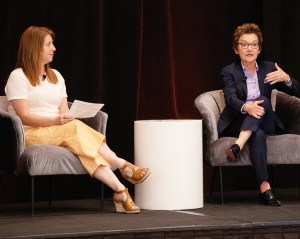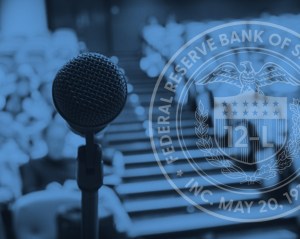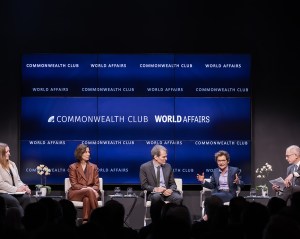Thursday, May 29, 2025
1:00 p.m. PT
Oakland, CA
Central BanksCommunity BankingEmployment & UnemploymentFederal Open Market Committee (FOMC)InflationInterest RatesLabor MarketsMonetary PolicyU.S. Economy
Transcript
The following transcript has been edited lightly for clarity.
Mary C. Daly:
Thank you. Thank you for that nice introduction. Thank you for this. If you wonder, I moved to Oakland in 1996. I love Oakland. The day I came here, my wife and I moved here and I said, “We are home.” So Oakland is my place. Thank you.
David A. Stein:
All right. Hopefully, we got both mics working now.
Mary, I wanted to start with a little primer on the Federal Reserve. I’m sure that most Rotarians know that just a few years after Oakland Rotary was formed, the Federal Reserve Act of 1913 established the Federal Reserve System as the Bank of the United States to provide the nation with a safer, more flexible and more stable monetary and financial system. So maybe you can tell us a little bit what is the Federal Reserve? We’ve heard that there’s a committee that sets interest rates, but what else does the Fed do and how does the Fed go about making policy decisions?
Mary C. Daly:
Absolutely. So let me start back in 1913, Congress put together the Federal Reserve. It was we take our work from them, Congress set the Federal Reserve Act and also the priorities that the Federal Reserve should focus on. They included three core responsibilities, monetary policy to promote a stable and healthy economy that gets materialized as price stability and full employment, low and stable prices and as much employment as we can sustain, conditional on that price stability goal. The second core responsibility is the payment system, making sure we have a safe and sound payment system. So whether that’s cash or wire, et cetera, we have the payment rails that we have responsibility to make sure that when Americans want to have their resources, they can find those resources. And then the third responsibility is with other regulators participate in a sound and safe banking system. When you show up at your bank, that bank has your money and has the ability to give you the funds that you’ve deposited. Those are things that the Federal Reserve was asked to do, and those are the responsibilities we carry out every day.
So all the teams across the country, both at the Federal Reserve Banks and at the board of Governors are all focused on those core responsibilities. We have people working in payments, we have people working in supervision and regulation for the banks, and we have people working in monetary policy. Now, how do we set interest rates? When we go behind those closed doors and we set the interest rate, we’re actually having a very robust discussion about how to serve the American people the best with the two responsibilities that Congress gave us, price stability, full employment. It is a completely apolitical process, and the way we source our information is we have all the data, we have all the history, we have models, we have theory, and then we have you. So we get some of the most accurate and up-to-date information we can find from talking to businesses and communities and our civic leaders, and finding out how people are responding in the lived economy, the experienced economy. If we simply looked at models and we looked at data and we looked at history, we would have an incomplete picture.
And so if you leave with nothing else today, I want you to have something in your mind, that data is a plural word, it’s not a singular word, and it is not just the headlines you see on inflation and unemployment. It’s all the information that myself and the other 11 Reserve Bank Presidents and everyone at the Board of Governors collects from our businesses and our communities and our civic leaders that tell us how the economy has been, but also where it’s headed.
David A. Stein:
So you mentioned the two congressionally mandated goals are price stability and full employment. And I believe the Fed has a specific goal of 2% in inflation, as your inflation goal. So I want to start with the other one, which is the full employment goal. What is the full employment goal? Is there a specific number or something you look at and can you give us a sense of how you view the current labor market?
Mary C. Daly:
Sure. So the full employment goal, unlike the price stability goal, is not a fixed number because it is about how much the economy can do, how fast the employment can grow and it’s linked in many ways since we have a dual mandate to balancing the concerns about inflation, getting it at 2% with the not cutting off the job expansion, the job expansion that can come if we let the economy run. So if you remember, the easiest way I can describe this is, if you remember back before the pandemic in 2019, we were in the 11th year of the longest expansion in our recorded history in the United States and the labor market was continuing to be robust. And in 2018, there were calls that maybe we should start bridling the labor market because it could spur inflation. But we chose not to do that at the FOMC.
And one of the factors that influenced my choice is our job is not to cut off strong growth in the labor market or strong growth in the economy, our job is to do those two things collectively. So it’s not a fixed number because a fixed number could leave you thinking that you were already there when in fact many people could come to work and they could be absorbed.
What was the second part of your question? Oh, where do I think the labor market is today? I really think the labor market’s in solid shape. If you think about what solid shape feels like, it feels like firms can find the workers they need and workers can find the jobs they want. And it may take a little longer to find a job and you may not get six offers, like you were doing in the frothy area of the labor market, but that is the balance that we need to have a sustainable labor market that is consistent with 2% inflation. And when I go out into the communities, no matter where I am, whether it’s, I was just in Alaska, Salt Lake City, Boise, Idaho, going to LA, later here in Oakland, what I see is that workers are getting the jobs they want and they are worried most about the inflation, which we still have to get down to 2%.
David A. Stein:
Well, so let’s talk about the inflation in 2%. Are you going to get there this year?
Mary C. Daly:
I can’t guarantee we will get there this year. In fact, that’s not necessarily my forecast. But what we are doing, and I think this is very good news, is we’re really making progress. I think all of us can remember the 7% and as a central banker, I really remember it because it was on the faces of all the people, who I serve, in a pained way. It was really, it’s just inflation is one of those things that robs people of their well-being. They work hard, they get a nice job, they get a good wage, they’re working as hard as they possibly can, and they see their purchasing power eroding or their savings not able to be growing the way they did. So we might not get there this year, but we are making progress and importantly, we remain resolute to get the job done.
David A. Stein:
So you kind of touched on it a little bit, but maybe you can elaborate. There’s a connection between dealing with inflation and dealing with employment and those two things frequently conflict or can conflict. So when you get behind those closed doors and you’re talking about it, how do you weigh those? How do you deal with that conflict?
Mary C. Daly:
Absolutely. In fact, in many points in history, these goals do not conflict, right? We call that in economics, this is not an FOMC term, but it’s an economics term, the divine coincidence because it means that we have two goals, price stability, full employment. We have one tool, the interest rate and all the communications around the interest rate, but it’s one tool. So the divine coincidence is when you can do one thing with your tool and you can accomplish both goals or support both goals. Now sometimes, as you mentioned David, those are in conflict. You have higher inflation than you would like, and you have lower employment than you think is full employment.
And then you have this trade-off space, and then you balance the risks. And we have this in our long-run statements, but you’re balancing the risks. How do you balance the risks? Well, you’re weighing what’s the risk to the economy in its longer-run, medium-run stability if inflation is a little above its target relative to employment is a little below our target, our full employment goal. And you’re balancing those risks and you’re balancing not just today, but over time because monetary policy works with a lag. It can take 18 months before an interest rate change fully gets itself through the economy. So we’re taking those things into account and ultimately it also matters how far away we are from our goals. If we’re very far from one goal and very close to another one, well, then we’re really trying to bring that one back into balance. So think of it as a scale almost, and we want to accomplish both, but we have to make sure we’re getting there in a way that is consistent with that promoting long-term stability in the economy.
And I’m always reminded from my own upbringing. I like, so many people in the room probably, well, I came of age in the late ’70s, early ’80s thinking about, watching my parents and everyone in our community, it was not just my parents, struggle with high inflation and then struggle with the Volcker Disinflation that cost jobs. And so ultimately, that was something that the Chairman thought he had to do to get these things re-anchored, but that’s what we want to avoid having to do. So the best way to deal with not being in that conflict is to try to do your best before you get there.
David A. Stein:
So changing the topic a little bit, two weeks ago, Moody’s downgraded the US credit rating and Treasury Bond yields are rising. Should we be concerned and does it make your job harder and what are you doing about it?
Mary C. Daly:
So the Federal Reserve, and it’s worth repeating here, even if many of you know it, the Federal Reserve, we don’t make policy, the fiscal policy in the United States, we make monetary policy. We are, by definition, reacting to the economy we have and working towards the economy for tomorrow by accomplishing the price stability and full employment goals that Congress gave us. So in central banking, you usually don’t evaluate, and I certainly don’t, whether my job is harder or easier, I’m always focused on the same things, price stability and full employment. And one thing you can see in bond yields or any other financial variable is that markets are trying to process the uncertainty that we all feel, I think, about how the economy will evolve and what the policy changes will be in the end and I see that in businesses, et cetera. So when I think about any financial measure right now, whether it’s the stock market or bond yields, et cetera, I recognize that they’re going to have day-to-day or even week-to-week fluctuations. But what are the fundamentals? And I go back to the following thing.
Right now, policy, monetary policy is what I think of as a good place. It’s where it needs to be to continue to bring inflation down. And the economy is in a good place. We have declining inflation, it’s gradual, but it’s coming down and we have good growth and solid labor market. Those are the things that mean we have a reasonably good economy that has its footing under it. So even with the uncertainty, I think we can look back and say, and with the uncertainty about financial markers, we’re in a good place right now and that’s what financial markets ultimately come back to. And that’s why you see the things fluctuate, but they come to something that seems fairly reasonable.
David A. Stein:
So you mentioned uncertainty and we live in a time when there’s rarely economic news. Last week, for example, the US House of Representatives passed the One Big Beautiful Budget Bill act, which Congressional budget office estimates will increase the federal deficit by $2.3 trillion over the next decade. President Trump threatened 50% tariffs on EU and 25% tariffs on our Apple iPhones. And then of course yesterday, the Federal Trade Court blocked many of the tariffs and we’ve had dramatic policy changes in immigration policy and changes in deregulation policy or a move to deregulation. So how do you deal with these many moving parts and how do they impact what you’re doing?
Mary C. Daly:
And it’s a great question. I start always with this. So I started the Fed in 1996. So I’ve lived through, in my role as an economist working for the Fed and now as president, many of the fluctuations, changes in administration, changes in the economy. And one thing I know about administrations as they change and our elected officials are different and they have different agendas is that they all come in. You can look back in time, they all come in with a slate of things that they would like to do, proposals. And those proposals, I have to look at three things. First, how do those proposals get augmented, changed, modified as they work through the governance of our country, either with Congress or voters or the legal system, et cetera. So that’s thing one. Second is what is the end state then and what then is the scope, magnitude and timing of that end state? And the third thing is what’s the net impact?
So I would say at this point, we don’t know any of those things yet, right, because the proposals are there and there’s negotiations on trade and Congress is negotiating how they think about things on a variety of other policies. And we’re working through those because deregulation and tax relief is usually a net positive for growth. Of course, immigration is, we don’t know, it depends on whether those immigrants, we need them for the workforce or the workforce is sufficient in the domestic workforce. And then on tariffs, the tariffs are you have to ask yourself how high are they, what’s the magnitude, what’s the scope and what’s the timing? They’re usually not a light switch, and you can see even now they’re being negotiated and they’re changing over time. So it would be premature to speculate how any of this will work out.
So what we do instead as Reserve Bank presidents and as the Federal Reserve system more generally is we ask, we ask businesses. So I spent a lot of time since the beginning of the year asking businesses, “What are you doing?” And here’s what I’m hearing, “Well, we’re very uncertain and we don’t like uncertainty.” No business likes uncertainty. The second thing though is that I asked them is, “What are you doing in terms of your plans?” “Oh, we’re just continuing to go, where if we had a development that we were going to do or a business outreach, we’re going to do that.” In all of the cities I went to that I named, there are cranes everywhere. Boise, Idaho, cranes are dominating the skyline, they’re continuing to build.
What’s different is if you don’t take the tail of the risk distribution on your projects. If you thought you wanted to open 50 stores, you might open 30 stores. But that’s not the same as putting pencils down. That’s not like we’re not going to plan, we’re not going to build. This is just a more moderate growth path. And honestly, that’s probably what we would’ve seen some of anyway as the economy slows and businesses reassess. So what I hear the net-net is businesses are still waiting to see and as they wait to see, we wait to see because we have policy in a good place for the economy we have and we have plenty of opportunity then and time to make decisions as the economy evolves.
David A. Stein:
So I’m going to change the subject a little bit here. According to a 2022 Federal Reserve Bank of St. Louis study, there’s been some improvement in the wealth gap between 2019 and 2022, but the gap still remains large. 2% of the population owns nearly half of the wealth in the United States, 7.5% of the population have more debt than assets, gaps between white families and black and Hispanic families remain large, gaps between younger and older families are at an all-time high and middle-aged family wealth peaked in 2007. What’s the Fed’s role with respect to the wealth gap and what action is it taking?
Mary C. Daly:
So this is where, as a central banker, you realize how limited you are. Congress purposely limited us to those goals that I told you, price stability, full employment. So we don’t have a role or a tool. We have one tool, the interest rate, and we have two goals. So we don’t have a role or a tool in the wealth gap, the income gap, the wage gap. But here’s what we learn by looking at history, and this is something I’ve studied throughout my career, is that a durable expansion actually closes gaps. So what the Fed is really doing is, by following congressional mandates for us, creating a strong and stable economy through price stability and full employment, is we can help with the conditions that allow all the other, the elected officials, businesses, communities to help close those gaps.
2019, the end of that expansion that only ended with the global pandemic, the remarkable thing about that expansion was it started to lift so many boats and as it lifted so many boats, the gaps closed. So the idea that I have, as I think about what our job is, is fulfilling the congressionally-mandated goals of those price stability and full employment, and that lays the foundation and the conditions for these other things to happen. That’s ultimately what I’m doing every day.
David A. Stein:
So my final question before we open it up to audience questions is to ask you to look into your crystal ball, hope you brought it with you today. What’s your current outlook for the economy, both the broader US economy and also for California and the Bay Area?
Mary C. Daly:
Sure. So let me start with the US, as you asked. So what I see when I go out is a general sense of cautious optimism. Yes we’re sitting with considerable uncertainty right now, but we saw after the pandemic, Americans want to work, they want to spend, they want to be out, and so I still see that. And when I’m talking to business leaders, they understand they have challenges, but they’re not just going in the room and sitting on the sidelines. They’re active. Look at all of you, you’re here. This is one of the reasons I love going out on, if you sit in your office, you can often think and use economic models. You can often think the picture’s gloomy. But when you go out in the communities and you talk to people, you see that sense that we can go forward and we can do things.
So my outlook is that we’ll continue to bring inflation down over time. We’ll continue to have a solid labor market that it’s going to be slowing, in all likelihood, but it will be solid. And that we’ll ultimately be able to manage the policy changes as needed so that we can support that development. Of course, things can happen. The uncertainty we have can be resolved in a way that doesn’t support that. But today, from where I sit, I see those positive developments occurring.
On the California and Bay Area, I was remembering to one of my younger team members at the San Francisco Fed that one of my first jobs when I came was to think about whether the Bay Area was really going to be important anymore because as Austin, Texas and Seattle and other, Portland, Oregon came up, we would be eliminated as a center for innovation and other activities. And I remember looking out my window and seeing the Bay and seeing the Golden Gate Bridge and seeing all the people and how entrepreneurial they were in the Bay Area, and I’m living in Oakland, and I’m like, “That’s not going to happen.” And so I have the same spirit now. Yes, the pandemic hit us hard in the Bay Area, and I think no matter where you live, you felt it. But there’s activity coming and people have an entrepreneurial spirit. We live in a beautiful place with a highly skilled and educated workforce and people want to participate. And so I’m bullish on California and on the Bay Area because ultimately we can meet our challenges and we move forward.
And I think the Oakland Rotary, from what I heard in your business meeting, you’re at the forefront of that for our community. So thank you.
David A. Stein:
We’re going to take some questions. We’ll start with you, Mack. I’m going to hold the mic.
Audience Member 1:
First of all, thank you very much, Dr. Daly for coming and sharing your insights with us. It is very much appreciated. This question connects to the ongoing debate about voting rights legislation and its potential impact on civic and economic engagement. Considering recent legislative efforts, you know what I’m saying, like the SAVE Act and the John R. Lewis Voting Rights Advancement Act, how does the Fed view the relationship between civic engagement, voting rights and economic participation?
Mary C. Daly:
Sorry, I always have to repeat this, but it’s useful to know that I have no role, as a Federal Reserve official, I have no role in the civic or elected or the voting rights, et cetera. Why that’s so important that I don’t comment on those things is because our independence, as a Federal Reserve making monetary policy, is essential. And our independence is best kept by keeping within our lanes, if you will, within the congressionally-mandated goals that Congress gave us. So that’s how I’ll do that part.
The thing that I do know is that when people participate economically, they tend to participate civically. And so the role that I can play even in this way is to do my job, to actually achieve full employment and price stability and have people be in the community. If your bandwidth is constantly taken worrying about how you’re going to feed your family or support your communities, then I think you have little time for other things. But if we support the economy in the way that we’ve been asked to, then it allows for these things to be taken.
So thank you for your question, and it is a good reminder for all of us that our independence is best kept by staying on the things that we’ve been asked to do by Congress.
David A. Stein:
Mary Gion. The lady’s got the mic.
Audience Member 2:
Yes. Hi. Yes. My name is Mary Gion, so we share the same name together. I also want to share with you that in the 1980s as a CPA, I work at the Federal Reserve Bank at your old location in Samson.
Mary C. Daly:
Oh, yes.
Audience Member 2:
And then, they moved to Marcus Street and I was there also. It was a great place to work.
David A. Stein:
Keep it short, Mary.
Audience Member 2:
Okay. I have a question. So you mentioned about the independence of the Fed. Now recently we heard that the Trump administration is attacking the independence of Chairman Jerome Powell. How’s he reacting to this?
Mary C. Daly:
We react, the Chair now, Chair Powell, all previous Chairs, it’s not the first time that administrations have asked the Federal Reserve to move in a way that they would like, but that’s just part of the job. So as a central banker, you’re tasked, in the United States we’re tasked with full employment and price stability, and we’re accountable to Congress, but also to the American people. And so when I go to work and I think about what I’m doing, that sign that we put up, it’s real. Our work serves every American and countless global citizens. And that’s what Chair Powell, who I know well, that’s his idea space. And so it was announced today that he met with the President and repeated those things. We will do what’s right, given our congressionally-mandated goals to achieve price stability and full employment. I guess, ultimately, Mary, I will say that if you’re in central banking, you really have to know your responsibilities and stick with those and be resolute because if we don’t, then Americans suffer.
David A. Stein:
Elida.
Audience Member 3:
Hi, my name is Elida Scola and I have a small frame shop on Grand Avenue in Oakland. If you don’t have a framer, by the way, I’m doing a good job. At any rate, what I’m trying to figure out is we import things from Italy and from other countries, and I know that we’ve had, just the last month was the worst month, I think, in 45-year history. And I think people are very concerned about what’s going to happen. Is there something that you can help me with in how I can communicate with my clients about their fears?
Mary C. Daly:
One of the things that I can tell you is that I was looking back on this too, mostly to help younger people who are working for us. I started in ’96, so I’ve lived through the dotcom, I’ve lived through the East Asian financial crisis, 9/11, at the Fed, 9/11, the global financial crisis, that was a devastating period of time, and then the global pandemic. And what I learned in all of those is that talking to your clients, talking to our people, telling them what you’re thinking and what you’re struggling with actually really helps. So if your clients or anyone, if your communities think you’re just doing it to them, then it’s much different than if you think this is what our margins are, this is where we are. And I saw that in the pandemic. In the pandemic, I would go around and take pictures of the price list and the prices were just being, as inflation started to rise, they were just crossing them out and writing in Magic Marker and then crossing them out again and writing in Magic Marker because the prices were escalating so quickly.
And it was really hard on small businesses in particular because they felt like they were passing something along to their customers who probably didn’t have the ability to do it. But I think that conversation helps. It’s a time for us to, as humans, be in more conversation because ultimately, we’re all in this uncertainty together. But I also think it’s important to realize that we have the fundamentals in a good place, our economy is in solid shape, and inflation is thankfully going down. So we are all going to be getting into a better place going forward.
Audience Member 3:
Thank you.
David A. Stein:
I think we have time for one more last question. Last question, Michelle.
Audience Member 4:
Hi. Thank you. I’m Michelle Himmelberg, and I may be asking you to put more of your academic hat on with this one, but the Fed’s metrics, which you’ve explained so well, have been in place for more than a century. Is it time to revise those, change those mandates?
Mary C. Daly:
I don’t think it’s a good time to change the mandates. I actually think the mandates are a very valuable piece. Congress gave them, so it’s not my role to change them, that would be Congress’ role. But I have to say that ultimately when I go out into communities and talk to people about what we do, they care about jobs and they care about inflation. And so us being tasked with the job of whether it’s a challenging one or an easier one, tasked with the job of putting both of those into balance is a good thing. Now, on the inflation target, for instance, 2%, we put that in place as a target in 2012 and ultimately, we review our framework for how we execute on that every five years. We’re in the middle of a framework review right now. You might hear about that if you read the news. We are actively working on these issues, and we’ll announce a new framework, which is going to come out sometime this year, as the Chair has said. But the mandates, the mandates I really believe in, and I continue to believe in our 2% inflation target.
David A. Stein:
So President Daly, thank you for your time, for your insight.
Mary C. Daly:
Thank you.
David A. Stein:
I really appreciate it. Looks like you’re going to get a standing ovation.
Mary C. Daly:
Appreciate it, thank you.
David A. Stein:
So I’m not the only one who appreciates it. So, thank you very much.
Mary C. Daly:
Thank you.
Summary
San Francisco Federal Reserve Bank President & CEO Mary C. Daly sat down with David A. Stein, President of the Oakland Rotary Club, for a conversation on the economy and monetary policy.
Quick Clips
From the Event
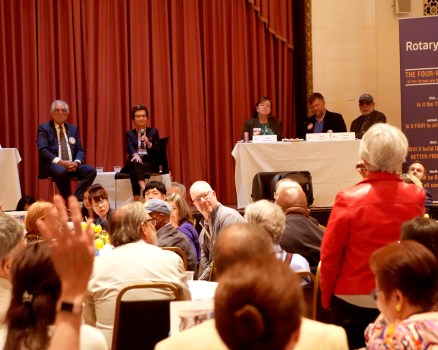
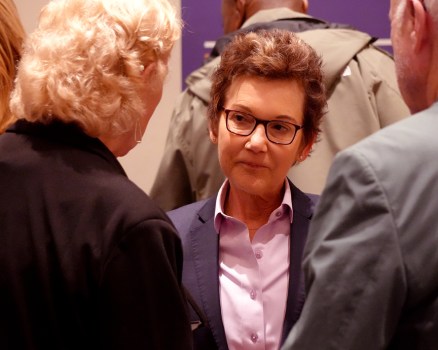
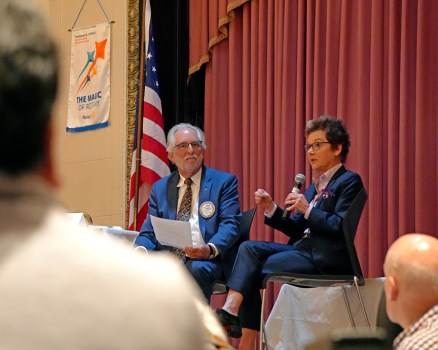
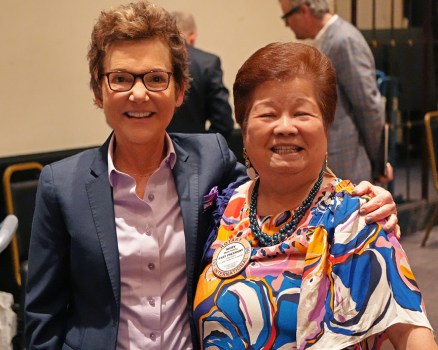
Sign up for notifications on Mary C. Daly’s speeches, remarks, and fireside chats.
About the Speaker
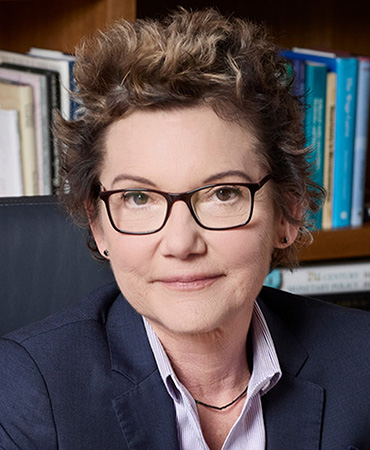
Mary C. Daly is President and Chief Executive Officer of the Federal Reserve Bank of San Francisco. In that capacity, she serves the Twelfth Federal Reserve District in setting monetary policy. Prior to that, she was the executive vice president and director of research at the San Francisco Fed, which she joined in 1996. Read Mary C. Daly’s full bio.
